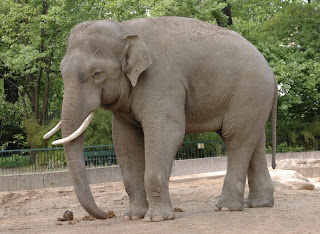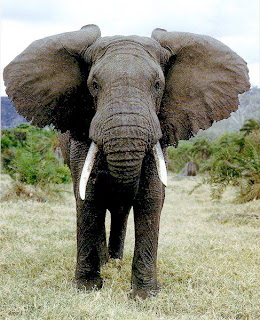Elephants
FAST FACTS
Height: 5-14 ft at shoulders (males); females of all subspecies are smaller than males.Length: Up to 30 ft trunk to tail.
Weight: 6,000-15,000 lbs (males).
Lifespan Up to 70 years.
There are two distinct species of elephants: the African elephant (genus: Loxodonta) and the Asian elephants (Elephas maximus). There are a number of differences between the two species – overall size, ear size, tusks and shape of the back and forehead among others.
 |
| Loxodonta |
 |
| Elephas |
Of these two species, African elephants are divided into two subspecies (savannah and forest), while the Asian elephant is divided into four subspecies (Sri Lankan, Indian, Sumatran and Borneo). Asian elephants have been very important to Asian culture for thousands of years – they have been domesticated and are used for religious festivals, transportation and to move heavy objects.
Did You Know?
Elephant ears are large, thin, and full of veins. This allows blood to circulate through them and help cool off this large mammal. When they fan their ears, they're looking to cool off!
Diet
Staples: Grasses, leaves, bamboo, bark, roots.
Elephants are also known to eat crops like banana and sugarcane which are grown by farmers. Adult elephants eat 300-400 lbs of food per day.

Population
At the turn of the 20th century, there were a few million African elephants and about 100,000 Asian elephants. Today, there are an estimated 450,000 - 700,000 African elephants and between 35,000 - 40,000 wild Asian elephants.
Range
African savannah elephants are found in savannah zones in 37 countries south of the Sahara Desert. African forest elephants inhabit the dense rain forests of west and central Africa. The Asian elephant is found in India, Sri Lanka, China and much of Southeast Asia
Behavior
Elephants form deep family bonds and live in tight matriarchal family groups of related females called a herd. The herd is led by the oldest and often largest female in the herd, called a matriarch. Herds consist of 8-100 individuals depending on terrain and family size. When a calf is born, it is raised and protected by the whole matriarchal herd. Males leave the family unit between the ages of 12-15 and may lead solitary lives or live temporarily with other males.
Did You Know?
Elephants don't have bones in their trunk, just muscle, and can use them with extreme dexterity, to pick up and manipulate even very tiny items.
Elephants are extremely intelligent animals and have memories that span many years. It is this memory that serves matriarchs well during dry seasons when they need to guide their herds, sometimes for tens of miles, to watering holes that they remember from the past. They also display signs of grief, joy, anger and play.
Recent discoveries have shown that elephants can communicate over long distances by producing a sub-sonic rumble that can travel over the ground faster than sound through air. Other elephants receive the messages through the sensitive skin on their feet and trunks. It is believed that this is how potential mates and social groups communicate.

Reproduction
Mating Season: Mostly during the rainy season.
Gestation: 22 months.
Litter size: 1 calf (twins rare).
Calves weigh between 200-250 lbs at birth. At birth, a calf's trunk has no muscle tone, therefore it will suckle through its mouth. It takes several months for a calf to gain full control of its trunk.
Climate Change and Other Threats
Habitat loss is one of the key threats facing elephants. Many climate change projections indicate that key portions of elephants’ habitat will become significantly hotter and drier, resulting in poorer foraging conditions and threatening calf survival. Increasing conflict with human populations taking over more and more elephant habitat and poaching for ivory are additional threats that are placing the elephant’s future at risk.




Comments
Post a Comment